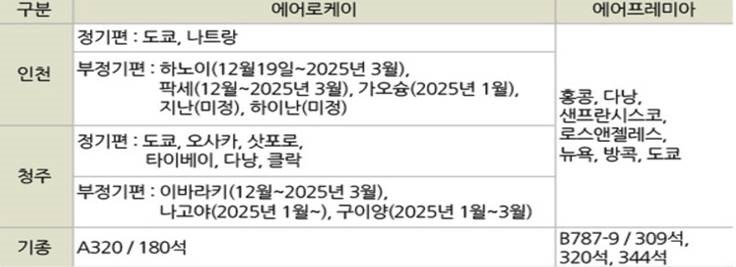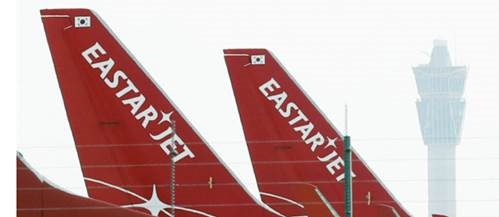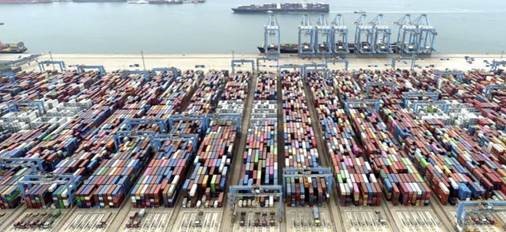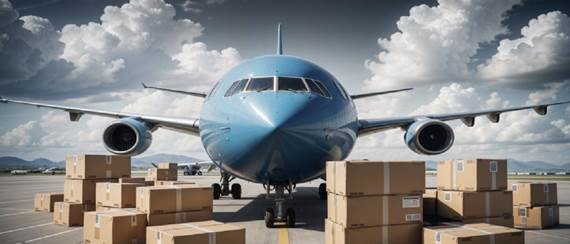엑스트란스 - 항공 물류 업데이트 - 48주차 블로그
항공화물 General
1) 에어프레미아·에어로케이, 내년에는 어디로 뜰까

- 이제는 ‘신생’ 딱지를 뗀 항공업계의 후발주자 에어프레미아와 에어로케이의 내년 노선 전략은 무엇일까?
- 에어프레미아와 에어로케이가 운항하는 노선을 살펴보면 양사는 창립 초기 계획대로 완전히 다른 길을 가는 중. 에어프레미아는 300석 이상의 중대형 항공기 B787-9를투입해 중장거리 노선에 집중하는 한편, 에어로케이는 180석 규모의 A320 단일 기종으로 비행시간 4시간 내외의 짧은 단거리 노선을 공략 중 .
- 에어프레미아는 확실하게 미국 노선을 중심으로 네트워크를 확대. 그동안 프랑크푸르트, 오슬로, 이스탄불 등 유럽 노선도 부정기편을 운항한 이력도 있지만 11월 현재 에어프레미아는 장거리 정기편으로 샌프란시스코, 로스앤젤레스, 뉴욕까지 미국에만 3개 노선을 운항 중. 그중 뉴욕 노선은 내년 1월7일부터 주5회에서 주6회로 증편 운항. 내년 항공기가 추가 도입되면 뉴욕 노선은 매일 2회 운항하는 것을 목표. 또 내년 상반기에는 하와이 노선을, 하반기에는 시애틀 노선에 신규 취항을 준비 중인 것으로도 알려짐. 하와이 노선의 경우 지난 동계 시즌 부정기편으로 운항한 경험이 있는데 당시 탑승률은 1월 75.1%, 2월 87.2%, 3월 62.7% 보임.
- 하지만 올해 연말, 기존 기종보다 좌석수가 더 많은 344석 규모의 6호기와 7호기 도입을 앞둔 에어프레미아는 중단거리 노선의 비중도 점차 확대하겠다는 움직임. 가시적으로 확정된 중단거리 노선으로는 방콕, 다낭, 홍콩으로 내년 1월24일부터 인천-방콕 노선을 주5회에서 주7회로 증편하고, 인천-다낭(1월23일~), 인천-홍콩(1월24일~) 등 약 4시간 거리의 단거리 노선에도 순차적으로 신규 취항하겠다는 계획.
- 반면 에어로케이는 1~2시간 거리의 일본과 중국 노선을 중심으로 단거리 노선을 자주 왕복하는 전략에 집중하겠다는 계획. 지난 5월부로 청주국제공항의 거점 항공사 의무에서 벗어난 이후 인천-도쿄를 시작으로 나트랑 노선까지 정기편을 운항하고 있는 한편 올 겨울에는 하노이, 팍세, 가오슝 노선에 전세기 운항을 추가할 예정.아직 구체적인 일정은 정해지지 않았지만 중국 지난과 하이난 노선에도 부정기편을 준비 중. 또 에어로케이의 경우 계절성 수요가 높고 다른 항공사들과의 경쟁이 적은 소도시 지역과 여행사를 대상으로 진행하는 전세기를 다양하게 투입해 시장성을 테스트하는 모습도 보임.
2) 항공업의 '메기' 대명소노 - 이스타항공의 행방은 ?

- 국내 저비용항공사(LCC) 업계에 지각변동이 예상되는 가운데, 지난해 사모펀드(PEF) 운용사 VIG파트너스를 새 주인으로 맞은 이스타항공의 향방에 관심 집중.
- 항공업계에서 빠르게 발을 넓히고 있는 리조트·호텔 기업 대명소노그룹이 원매자로 등장해 판도에 변화를 줄 가능성도 거론.
- 향후 이스타항공이 인수합병(M&A) 시장에 매물로 등장했을 때 어디에 매각되느냐가 항공업계 중대한 분기점 될 것으로 보임.
- 대한항공과 아시아나항공의 기업결합 절차가 마무리되면 대한항공 자회사 진에어·에어부산과 아시아나항공 자회사 에어서울을 통합한 ‘메가 LCC’가 탄생.
- 여기에 최근 대명소노그룹이 티웨이항공과 에어프레미아의 2대주주로 각각 올라서며 범위를 넓힘. LCC 업계 재편이 불가피한 상황에서
- 이스타항공은 시장 지배력을 높일 수 있는 대상이라는 해석이 나옴.
- VIG파트너스는 지난해 1월 이스타항공의 지분 100%를 총 1450억원에 인수하면서 재무구조를 개선하고 공격적으로 사업을 확장.
- 지난 2021년 기업회생절차를 밟으며 파산 위기에 몰렸던 이스타항공은 VIG파트너스에 인수된 뒤 완전자본잠식 상태를 벗어남. 항공기 5대를 추가 도입하고, 신규 취항 노선도 크게 넓히는 등 외형 확장에 집중. 사업 정상화에 속도가 붙고 외형 확장을 이룬 만큼 매물로 다시 등장할 가능성이 크다는 게 업계의 중론.
- 유력한 인수 후보로는 대명소노그룹이 거론. 대명소노그룹이 이스타항공을 인수할 경우, LCC 업계에서 입지를 공고히 할 수 있는 기회가 될 것으로 보임.
- 대명소노그룹은 지난 2010년에도 에어아시아에 투자해 국내 영업권을 획득하기도 했고, 티웨이항공과 함께 같은 시기 이스타항공 인수를 검토하기도 함.
- 현재까지 대명소노그룹은 티웨이항공과 에어프레미아의 경영권 확보를 생각하고 있지는 않다는 입장이지만 업계에선 양사를 모두 인수해 합병한다는 시나리오도 유력하다고 보고 있으며, 이 경우 제주항공은 국내 LCC 1위 자리를 위협받게 될 가능성도 존재.
3) 트럼프 2기 대 중국 관세 - 동남아지역에 일시적 호재로 그칠 것

- 트럼프 미대통령 당선인측이 중국산 수입품에 최소60% 관세율을 적용할 뜻을 내비치고 있는 가운데, 이러한 대중국 관세 정책이 제조기지 탈중국 현상을 가속화하여 동남아지역에 단기적으로는 호재로 작용할 것으로 예상되나, 만일 차기 행정부가 태국이나 베트남 등 동남아 국가 우회 중국산 수입품에 대해서도 조치를 취하게 된다면 보다 광범위한 영향이 초래될 것이라는 전문가들의 분석.
- 베트남 등 동남아 국가들은 이미 지난 트럼프 1기 행정부의 대 중국관세 인상조치 때부터 수혜를 입어 왔음. 값싼 노동력과 빠른 속도의 인프라 확충으로 이미 여타 아시아지역 투자자들의 관심을 끌었던 베트남은 대중국 관세를 피해 직접투자 형태로 베트남으로 공장을 이전하는 제조업체들이 늘어나면서 큰 수혜 받음.
- 또한, 2030년까지 자동차 생산량의 30%를 전기차로 채우겠다는 야심찬 목표를 세운 태국은 유수의 전기차 브랜드를 포함한 다수 중국기업의 투자 유치 성공.
- 실제, 더 많은 중국 기업들이 동남아에 투자하고 있고, 중국자본을 사실상 현지화하고 있으며, 동남아 10개국으로 구성된 ASEAN에 대한 중국의 직접투자가 지난해 약 251억 2천만달러를 기록해 전년 대비 34.7% 증가했다고 전했음.
- 이러한 상황에서 내년 1월 트럼프 2기 행정부 출범과 함께 현재 면세대상인 중국산 아동용품과 생필품의 절반 이상에 관세가 부과된다면“말 레이시아, 싱가포르, 태국, 베트남, 인도네시아 등 동남아지역으로 공장과 사업장을 이전하는 중국기업들이 더욱 늘어날 것으로 예상.
- 그러나, 트럼프당선인은 제3국이 관세 우회수단으로 이용되는 것에 반대할 것임. 이번 유세기간 중 중국의 또다른 환적지인 멕시코에 대해 25% 관세 부과 위협함. 이와 관련, 미국의 대중 무역적자를 줄이기 위한 트럼프당선인의 노력은 중국의 우회수 출수혜국으로도 확대될 것이라고 전망.
4) 내년 항공화물 시장공급 부족 직면 예상 – 성장 둔화 · 수요 지속

- 지난주 열린 TIACA Air Cargo Forum에서 항공화물 공급측면에서 예상되는 문제점 중 업계가 직면할 가능성이 있는 주요 도전 과제들에 대해 언급.
- (1) 여객기 벨리 용량증가 둔화와 화물기 전환 지연
현재 항공화물시장은 여객기의 벨리 용량 증가속도가 둔화 중이며, 항공기생산이 지연되는 상황에서 여객기 시장의 높은수요가 화물기로 전환할 수 있는 기체공급을 제한하고 있음. 특히, 현재 전세계 항공기 가동률이 지난 5년간 최고수준에 이르러 기존 항공기에서 추가용량을 확보하기 어려움.
- (2) 전자상거래 수요증가와 지역간 용량 이동
특히, 아시아지역에서 전자상거래 수요가 내년에 20% 성장 할 경우, 다른 시장에서 용량을 이동시켜야 하는 상황이 발생할 수 있음. 예를 들어 중국발 수요가 20% 증가하고 공급량은 4.4% 증가에 그친다면, 결국 공급증가는 아프리카와 남미지역으로 공급 용량을 이동시키는 것 뿐임.
- (3) 장기적인 화물기 공급 문제
에어버스와 보잉의 새로운 와이드바디 화물기 프로그램이 지연되고 있으며, 현재화물기들의 평균연령이 계속 상승하고 있는 점도 문제임. 항공사들이 기존 항공기의 수명을 최대한 연장하려는 노력을 기울이겠지만, 이는 서비스 중단과 가동률 감소로 이어질 가능성이 큰 것으로 나타남.
- (4) 전자상거래와 글로벌 무역규제의 영향
수요 측면에서도 전자상거래 수요는 강세를 유지하겠지만, 일부 리스크가 존재함. 특히, 미국 등 주요국가들이 전자상거래 제품 수입을 규제하려는 움직임을 보이고 있으며, 이는 단기적으로 수요감소를 야기할 가능성이 있음. 그럼에도 불구하고 동남아시아와 남미와 같은 시장에서 전자상거래 성장 잠재력이 여전히 큰 것으로 분석. – 동남아시아 1인당 전자상거래 소비는 1.4kg에 불과하지만, 북미는3.3kg, 유럽은2.7kg로집계. 만일 동남아시아의 소비가 1kg만 늘어나도 엄청난 물량 증가가 예상.
- 5) 미·중 무역 갈등과 글로벌 공급망의 변화
미·중 무역 갈등이 내년에 단기적으로 항공화물 수요에 영향을 미칠 수 있지만, 장기적으로는 무역이 지속적으로 성장할 가능성이 높음. 특히, 베트남과 같은 대체 생산기지에서 수출이 증가하는 등 공급망의 이동이 활발해질 것으로 예상됨.
- 결국, 내년 항공화물시장은 제한된 공급과 강력한 수요 증가사이에서 큰 압박을 받을 것으로 보임. 특히, 전자상거래 수요와 글로벌 무역변화가 공급망 전반에 영향을 미칠 전망임. 이에 따라 항공사와 화물 운송업체들은 지역간 용량 재배치를 통해 시장수요에 대응해야 할 필요성이 커지고 있음
5) 항공사/GSA Movement
- 핀에어(AY) 조종사 파업 예고로 12월 수백편 항공편 취소 결정, 미주 아시아에서 유럽행 항공편 및 핀란드 국내선 운항 차질.
- EU, 대한항공의 아시아나항공 합병 승인

top



